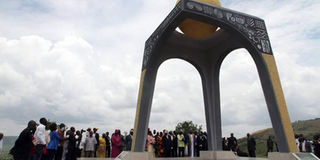Ankole resurrects 500-year-old eclipse feeling

Guests marvel at the Biharwe Eclipse Monument during its unveiling at Biharwe Hill in Mbarara Town last month. The monument was erected in memory of a total eclipse experienced more than 500 years a go
What you need to know:
The monument and a cultural centre were constructed to preserve the cultural history of the area
Along the highway before you reach Mbarara Town are two definite tourism sites on either side of the road - the Igongo Cultural Centre on the right side and on the left lies Biharwe Hill. On top of the hill is a monument. Before you climb the hill, you cannot estimate its actual size that appears bigger when one comes closer to it.
Erected through the initiative of James Tumusiime, the chairman Uganda Tourism Board, and also the proprietor of Igongo Cultural Centre, this monument goes back in time to revive the memory of a total eclipse that dates as far back as 1520 AD.
Eclipse experience
Many people think that the first eclipse in which Uganda was a focal view point was one that occured last year on November 3, best viewed at Owiny Primary School in Pakwach Town. Around 1520 AD, Mbarara witnessed total eclipse on Biharwe Hill, which was later named The Biharwe Eclipse.
“The story does not only lie on the eclipse that happened back then, it also dates back to the fights that the three contemporary kings were involved in,” Joshua Muvumba, a historian says.
It is believed that when the king of Bunyoro, Omukama Rwitamahanga Olimi I, was fighting the king of Buganda, Ssekabaka Nakibinge and Nkore’s Nyabugaro Ntaro I, this war was known as the Battle of Biharwe having ended on Biharwe Hill.
After King Olimi had attacked the two neighbouring kingdoms, he and his men raided all their cattle and were taking them to his kingdom. When they reached Biharwe Hill, they did not notice the place was experiencing total eclipse.
The mystery
As darkness suddenly fell, the king thought the demons of the people they had killed during the war had showed up to haunt them. He ordered his soldiers to abandon everything on the hill so they could run to save their dear lives. The natives took the abandoned war spoils, including the cattle and divided them among themselves. They named them the Empenda ya munoni (translated as cattle from heaven).
Reviving the story
The story has always featured as a folklore told by the elders until last month when a monument was constructed in memory of the event.
Just after the monument was unveiled, Igongo Cultural Centre was also officially opened. The centre lies just down the hill. The hill actually gives a good view of the cultural centre.

President Museveni (L) is shown around a section of the Buganda cottage at Igongo Cultural Centre museum. Courtesy Photos
During its launch, the two sites were toured by guests, who included President Museveni, Prince David Wasajja and other guests who represented Bunyoro and Nkore kingdoms. At Igongo Cultural Centre, guests were welcomed with a pot of milk (Enkongooro in Runyankore) instead of banquets of flowers.
The centre has a museum known (Erijukiro). The museum, which is the focus point of the centre, is home to special south western Uganda’s historical and cultural regalia. The museum also features a Buganda cottage where historical aspects of Buganda Kingdom will be kept for purposes of tourism and research.
President Museveni applauded Tumusiime for resurrecting the history and said his government will ensure the centre grows into a big tourist destination.
Tumusiime said the cultural centre is meant to fuse traditional society and contemporary culture.
About the monument
The monument was designed by Joseph Ssematimba from Makerere University School of Art. It has three pillars, which have a yellowish exterior with rough surface and stands on a wide tiled floor. On the top part of the monument sits an eclipse like feature. The surface on which it sits has different symbols, pictorials and Egyptian writings.
The features such as drums, shields and spears represent different things from different regions. The three pillars represent the three contemporary kings and their Kingdoms (Bunyoro, Buganda and Nkore).




